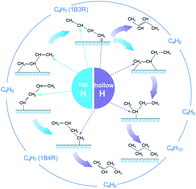当前位置:
X-MOL 学术
›
React. Chem. Eng.
›
论文详情
Our official English website, www.x-mol.net, welcomes your feedback! (Note: you will need to create a separate account there.)
The role of hydrogen coverage and location in 1,3-butadiene hydrogenation over Pt/SiO2†
Reaction Chemistry & Engineering ( IF 3.9 ) Pub Date : 2019-10-23 , DOI: 10.1039/c9re00371a Chaoquan Hu 1, 2, 3, 4 , Mingyuan Shao 1, 2, 3, 4, 5 , Maoqiao Xiang 1, 2, 3, 4 , Shaofu Li 1, 2, 3, 4 , Shuanghao Xu 1, 2, 3, 4
Reaction Chemistry & Engineering ( IF 3.9 ) Pub Date : 2019-10-23 , DOI: 10.1039/c9re00371a Chaoquan Hu 1, 2, 3, 4 , Mingyuan Shao 1, 2, 3, 4, 5 , Maoqiao Xiang 1, 2, 3, 4 , Shaofu Li 1, 2, 3, 4 , Shuanghao Xu 1, 2, 3, 4
Affiliation

|
Hydrogenation of 1,3-butadiene over supported Pt particles has long been known as a structure sensitive reaction, yet the nature of this phenomenon has not been well understood. We have previously addressed the reaction pathway for 1,3-butadiene hydrogenation over ∼22 nm Pt particles. In this study, the behaviors of SiO2 supported ∼2.9 nm Pt particles towards 1,3-butadiene hydrogenation have been investigated with the aim of providing a fundamental explanation for the structure sensitivity of this reaction. Interestingly, it was found that the product distribution for the present catalyst towards 1,3-butadiene hydrogenation was sensitive to temperature. However, the evolution of 1,3-butadiene hydrogenation over the catalyst with temperature was not captured by in situ diffuse reflectance infrared Fourier transform (DRIFT) spectroscopy. The detected carbonaceous species on the Pt surface are more likely to be spectators rather than reaction intermediates for the formation of butenes and n-butane. To understand the behaviors of the catalyst, density functional theory (DFT) calculations were employed to explore the pathways for the formation of the products with low activation barriers. The results show that the coverage and the location of the hydrogen atom are the two key factors for the interpretation of the behavior of Pt particles towards 1,3-butadiene hydrogenation.
中文翻译:

氢覆盖和位置在Pt / SiO 2 †上的1,3-丁二烯加氢中的作用
长期以来,在负载的Pt颗粒上进行1,3-丁二烯的氢化反应一直是结构敏感的反应,但是这种现象的性质尚未得到很好的理解。我们之前已经讨论了在约22 nm Pt颗粒上进行1,3-丁二烯氢化的反应途径。在这项研究中,已研究了SiO 2负载的2.9 nm Pt颗粒对1,3-丁二烯氢化的行为,目的是对该反应的结构敏感性提供基本解释。有趣的是,发现本催化剂朝向1,3-丁二烯氢化的产物分布对温度敏感。然而,通过原位反应不能捕捉到催化剂上1,3-丁二烯加氢随温度的变化。漫反射红外傅里叶变换(DRIFT)光谱。在Pt表面检测到的碳质物种更可能是观众,而不是形成丁烯和正丁烷的反应中间体。为了了解催化剂的行为,采用密度泛函理论(DFT)计算来探索具有低活化能垒的产物形成的途径。结果表明,氢原子的覆盖度和位置是解释Pt粒子对1,3-丁二烯氢化行为的两个关键因素。
更新日期:2019-12-18
中文翻译:

氢覆盖和位置在Pt / SiO 2 †上的1,3-丁二烯加氢中的作用
长期以来,在负载的Pt颗粒上进行1,3-丁二烯的氢化反应一直是结构敏感的反应,但是这种现象的性质尚未得到很好的理解。我们之前已经讨论了在约22 nm Pt颗粒上进行1,3-丁二烯氢化的反应途径。在这项研究中,已研究了SiO 2负载的2.9 nm Pt颗粒对1,3-丁二烯氢化的行为,目的是对该反应的结构敏感性提供基本解释。有趣的是,发现本催化剂朝向1,3-丁二烯氢化的产物分布对温度敏感。然而,通过原位反应不能捕捉到催化剂上1,3-丁二烯加氢随温度的变化。漫反射红外傅里叶变换(DRIFT)光谱。在Pt表面检测到的碳质物种更可能是观众,而不是形成丁烯和正丁烷的反应中间体。为了了解催化剂的行为,采用密度泛函理论(DFT)计算来探索具有低活化能垒的产物形成的途径。结果表明,氢原子的覆盖度和位置是解释Pt粒子对1,3-丁二烯氢化行为的两个关键因素。


























 京公网安备 11010802027423号
京公网安备 11010802027423号